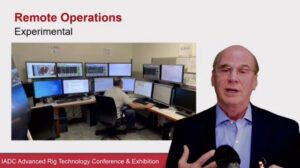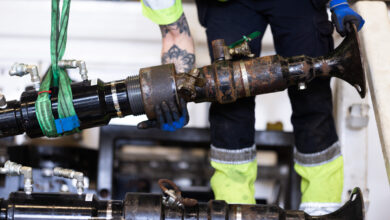Plug-and-play automation, emissions reduction among key factors in rig selection for Occidental Petroleum

By Stephen Whitfield, Associate Editor
During the first day of the 2021 IADC Advanced Rig Technology Conference on 19 October, John Willis, VP Drilling and Completions for Onshore Resources and Carbon Management at Occidental Petroleum (Oxy), discussed the ways in which the industry can use technology to address key challenges – in particular those associated with boom-and-bust cycles and ESG. He focused primarily on efforts in the three areas of remote operations, rig automation and reducing emissions.
Earlier this year, Oxy started up a remote center in Houston, allowing a single drill site manager to oversee multiple rigs. The site manager coordinates with Oxy staff at each rig, who are responsible for providing safety leadership and coordinating logistics on location.
The goal with the remote center is not to take people off the rig entirely; in fact, Mr Willis said there’s no reduction in people involved. Rather, Oxy sees remote operations as a means to augment the productivity of its current staff, especially as it increases activity coming off the oil price downturn.
While Oxy still has a ways to go before fully implementing remote operations, “it does look very promising to help us to get through some of the boom cycles,” Mr Willis said. “Without having to spend so much on training and suffering through the learning curve of a lot of new people, we think we’ll be better positioned with our staff, so that when we go back to a smaller operation, we’ll be able to retain the staff that we have working in the remote center.”
Scaling up remote operations will require technological developments in a couple of key areas. First, remote operations require installing more cameras on the rig to provide visual data. “We get a lot of information from the real-time data systems, but during times like running casing or rigging up, the top drives aren’t moving and the pumps aren’t running. We need cameras to tell us what’s going on then.”
Second, there must be more data collection. Remote operations require access to data from every component on the rig. “We will be collecting more and more data on the rig. We want data from the rig control system, but we’re also looking at collecting data from all the other (third-party) equipment on the rig. We need the data for remote supervision and to feed automation and data analytics systems.”
Data will also have to be better quality in order to drive automated systems and data analytics. “We’re going to need much more reliable, precise and well-calibrated instrumentation,” Mr Willis said.
Oxy is also looking for ways to better incorporate automation into its workflows. “When we go to try to buy automation, it’s really hard to get,” Mr Willis said. “We’re largely limited to what’s available from individual drilling contractors. It’s very difficult, if not impossible, to take something from another third party and add that to a rig. And none of our rigs have what we would consider to be a full system of automation today.”
So far, automation has not allowed Oxy to “capture knowledge” – allowing a less skilled driller to perform equally well as a more skilled driller by relying on automation for things like identifying bit dysfunction and ROP optimization. Today’s automation systems are still very complex to run, Mr Willis said. “The reality is that it takes a very skilled driller because they have to switch back and forth between the automation and the manual control system, which means they have to know all about the manual control system but also know about the automation system. There’s just a learning curve that we have to go through.”
Standardized interfaces will also be critical to automation efforts, Mr Willis said. Since Oxy is never working with just a single drilling contractor, it’s important for the company to be able to standardize certain systems across its drilling operations. While the drilling contractor’s automation system will be used as the primary system, Oxy would also like to augment that system with third-party systems can be plugged in. “We have certain apps that we want to apply on all of our rigs, so that’s a really important thing to us, and it’s something that will be a factor in our rig selection in the future.
When it comes to ESG, Mr Willis said that while the development of batteries for drilling rigs is “very intriguing,” hybrid rigs that incorporates both highline power and battery systems to reduce diesel fuel usage look even more promising. “To use 100% highline power, we have to have peak loads of 3-4 megawatts to handle the full rig loads. A lot of power lines and substations can’t handle that, and in some places in the community, they really don’t want to have those transient loads dimming the lights in the neighborhood. So that’s held us back from using highline power.” A great solution would be using some highline power, maybe 1-2 megawatts, then augmenting that with the rig engines for the peak loads, he added.
“In the Delaware Basin, we have four engines on our rigs, but we only need the fourth engine for probably less than 10% of the time that we’re drilling,” Mr Willis continued. “So, we could use three engines with a battery, and instead of spending the money on a fourth engine, we could put that money into a battery and we have a more flexible system. We could augment the power with highline and, for a lot of time, we could probably run the rig entirely off of highline power when we’re in lower power scenarios. This is a very intriguing option that we’re really interested in.”




